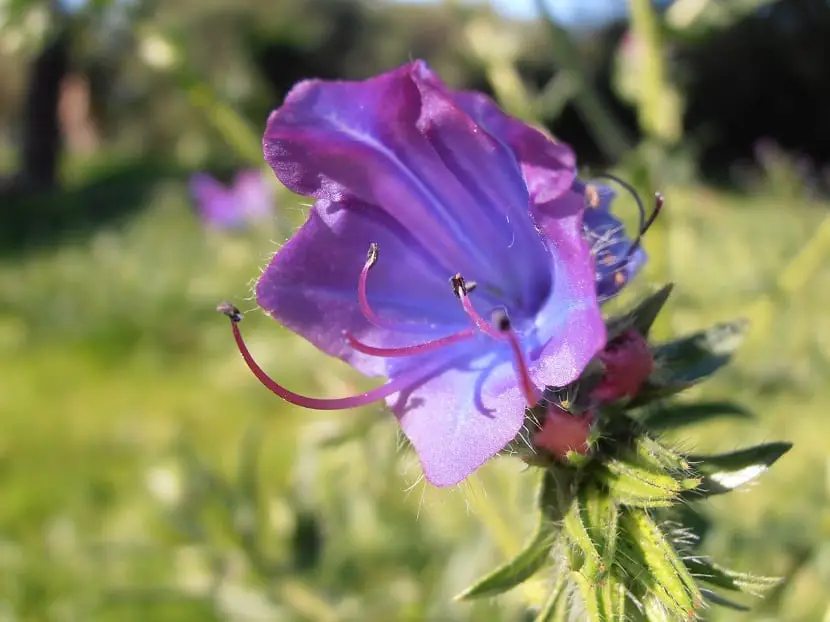
Echium Plantagineum is known by different names, among which are Cordial Flowers, Purple Flower Buglosa, Vine Chupamiel, Cow’s Tongue and Viborera, among others, the latter being a name that it obtained due to the resemblance between the seeds and the head of snakes.
It is part of the family Boraginaceae and it is an annual herb that manages to reach approximately one 100 centimeters high. In grasslands, this plant grows profusely when fully exposed to the sunsince it only tolerates half shade. Its flowering is in the spring and it is through insects that its pollination is carried out, in addition, its flowers grow about 3 cm.

The Echium Plantagineum consists of a variety typical of the Mediterraneanin which, it is also known as “Patterson’s curse”, although it is also naturalized in Australia, where it is called “Salvation Jane”.
It should also be noted that Echium Plantagineum has medicinal propertiessince it is possible to use the powdered plant in plasters as an antidermatotic and / or vulnerable. In addition, when cooking both the flowers and the leaves, an excellent diuretic is obtained, which at the same time is astringent, emollient, refreshing, sweaty and menstruating.
Varieties of the Boraginaceae family stand out for being rustic plantswhich are normally not affected by pests or diseases.
Characteristics of the Echium plantagineum
The Echium Plantagineum viboreras turn out to be biennial and / or annual herbswhich have one or more stems of erect growth, which have the capacity to reach between 20 and 100 centimeters high. These are rustic plants that do not only grow in grasslandsbut also in ditches, slopes, fallows and slopes. In addition, it consists of a very common plant both in Spain and in other parts of the European continent.
Although it has a somewhat rough appearance, because it is covered by a large number of hairs and mushrooms, the truth is that the Echium Plantagineum viboreras have beautiful petals of a bluish-violet colorwhich have a wide funnel shape, because their petals are less solitary at the ends, giving rise to the corolla lobes.
In general, the flowers of the Echium Plantagineum are located at the ends of the branches and especially in the upper peak of the plants; between them it is possible to see buds of a tone between reddish and purplewhich when opening, give rise to small flowers of the same color.
The flowers of the Echium Plantagineum are hermaphroditic and have five stamens that are inserted at different heights of the corolla (usually two of them exerted) and protrude from it, which have slightly hairy purple filaments, in addition to blue anthers. The style of color similar to that of the filaments, turns out to be longer than the corolla and includes a stigma that stands out for being bifid and it is worth mentioning that the generic name Echium Plantagineum, as well as the more usual variants, Viperina and Viborera, such as already mentioned above, refer to the great similarity that exists between the fruits of this plant and the shape of the heads of snakes.
This type of plant is somewhat invasive, so the risk of invasion and spread it is kept in those countries where the plant is still grown for its flowers, but where the weed has not yet established itself.
The risk of local spread comes from grazing stocks that can ingest E. plantagineum and it must be remembered that this is a harmful herb for animalswhich can make the animal that consumes it suffer from vomiting and diarrhea for a few days.
Care for Echius Plantagineum

The Echium Plantagineum plant is generally located in watercourses and / or along roads; the beautiful and showy flowers that it has, are usually used in gardens as a beautiful ornamental plant and it is usually found in degraded places such as empty spaces and roadsides. Within its care, it should be mentioned that although it tolerates shade quite well, it is a plant that grows in optimal conditions when it is in a place where it is directly exposed to sunlight.
Must be on moderate heat environmentssince these have the ideal temperature for their proper development.
Regarding the soil, it should be noted that they have to be planted in montane soil, which basically refers to a dry land that must have a pH that is between 4.5-7.5 and that apart from having a high nitrogen content, it is weakly acidic. In addition, its underground part will develop better when being in soils that have a clay, loamy and / or sandy texture, since in general, these have the ability to remain wet or dry, providing the plant with exactly what it needs. .
The irrigation process should be adjusted to an intermediate point, that is, try to keep soil moisture at a constant leveltaking into account certain factors, such as exposure to sunlight, temperature, soil texture, humidity of the environment, among others. Similarly, a very interesting aspect that can be mentioned about Echium Plantagineum is that it is a plant that does not support waterlogging, so it is necessary that the planting place has good drainage.
Pests and diseases Echium Plantagineum

Yet no totally reliable information has been found on what type of diseases or pests can affect this plant, but we assure you that we are working quickly to find any type of information.
Uses that can be given to Echium Plantagineum
Inside the kitchen: By having edible leaves, it is possible to use them to prepare a salad by adding vegetables and other herbs, such as borage.
Therapeutic virtues: In general, the juice of this plant is used within the world of cosmeticsbecause it is a powerful emollient, especially in the case of reddened, sensitive and / or delicate skin.
Other uses: Its root offers a red coloring which is especially used in fabrics.

2 thoughts on “Echium plantagineum: characteristics, care and pests”